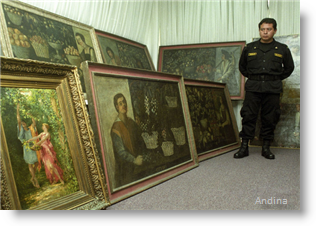 Peru’s government has repatriated over 8,000 pieces of cultural heritage over the past seven years, which had been smuggled out of the Andean country and sold on the black market, state news agency Andina reported.
Peru’s government has repatriated over 8,000 pieces of cultural heritage over the past seven years, which had been smuggled out of the Andean country and sold on the black market, state news agency Andina reported.
Blanca Alva, head of the department in charge of protecting cultural heritage, said that the items, including colonial paintings and archaeological artifacts, would be worth in total around $5 million on the black market.
The report said that the United States, Spain, Germany and Italy were home to the highest number of archaeological pieces smuggled out of Peru, while colonial goods were mainly found in Europe.
The pillaging of archaeological sites and the theft of cultural heritage has a long history in Peru. However, there has again been a rise in thefts of valuable objects from colonial-era churches in the countryside, where there is little security.
Alva said that in addition to the lack of security at village churches, the watchmen often don’t inform authorities of a theft.
“We often only find out about it when a piece is sold abroad,” said Alva. “We didn’t even know that the piece had been stolen.”
The thefts and grave robbing frequently are committed to meet specific demands of established dealers of smuggled antiquities, and shipping the objects out of the country takes many forms — in some cases of prehispanic pots or metal artifacts, the objects have been coated in clay and shaped into modern handicrafts and then smuggled across to Bolivia or Chile before being flown to their final destination.
According to Alva, Customs and police have taken steps to tighten controls at the borders with Ecuador, Bolivia and Chile. The success over the past few years has been the result of efforts by the police, Customs and the Foreign Relations ministry.
Peru was the seat of the Inca empire that stretched from Colombia to Argentina, and to a number of important ealier civilizaitons, before the arrival of Pizarro and his Conquistadors, when it became the center of Spanish rule in South America until the revolutions that led to the independence of Latin America from the Spanish in the 19th century.






To call upon other nations to repatriate anything Peruvian is to deny other countries’ citizens the knowledge, appreciation and magnetic appeal of Peru. Peru has many museums and all the artifacts it needs to attract citizens and tourists. Other countries’ citizens develop respect for Peru through art museums, and their natural curiosity leads to studies of Peru’s rich history. Who can deny the value of Houston’s Museum of Fine Arts, which holds a major exhibit of gold objects from Peru and elsewhere? The need is outside of Peru.
I believe you mean that the items have been repatriated *TO* Peru, and that over 8000 items have been repatriated *TO* the Peruvian government. What you have written is that the Peruvian government are sending items to OTHER countries, not having them returned.